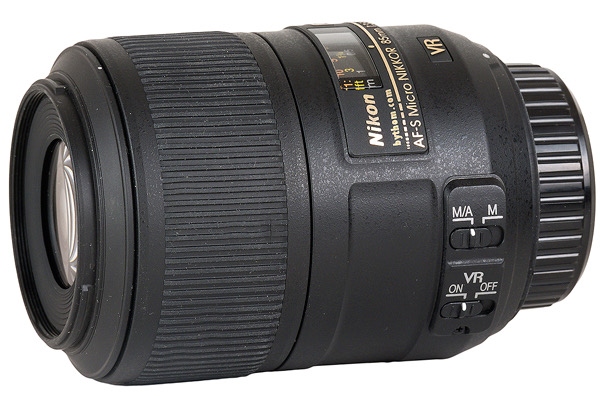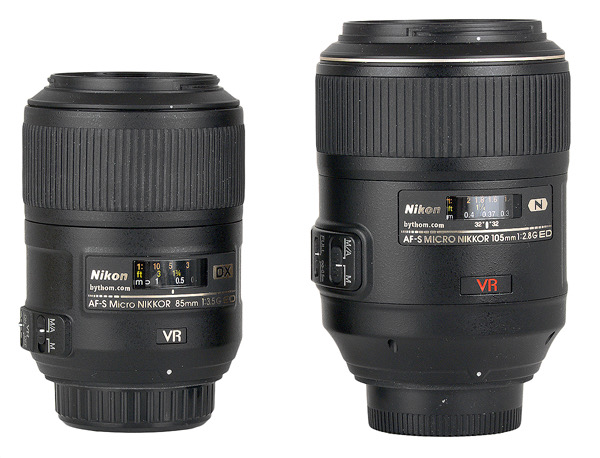This review originally appeared on bythom.com in September 2012. It has been updated since then, including the most recent changes for the dslrbodies.com site.

What is It?
In the FX world, Nikon makes 60mm (originally 55mm), 85mm (PC-E), 105mm, and 200mm Micro-Nikkor lenses. The 105mm is the most popular, as it is a nice balance between working distance and cost, and tends to be a focal length that is valued by many.
In DX, we have 40mm and 85mm (the lens being reviewed) options, plus all the FX versions, which means we have a plethora of choices. The question is which makes the most sense.
Right up front we have one thing that causes some to react negatively to the 85mm: the f/3.5 maximum aperture, which puts us a half stop slow on a system that's already a stop worse off than FX. The 127.5mm equivalent focal length is also at the long end of where most people want a prime telephoto lens. The combination means that the 70-200mm f/2.8 may be a better choice for 127.5mm, at least in some people's minds just looking at specs.
Like all the current Micro-Nikkors, this lens gets down to 1:1 (lifesize). That means objects at close focus are recorded the same size as they exist in nature. Given that the DX sensor size is about 24mm wide, that means if you focus on a 24mm-sized object at the closest focus distance, your object comes out full frame. Close focus is at 11" (0.29m), but your subject is very near the front element (5.6", or 141mm).
Which leads me to an aside: some Web sources incorrectly write that a 1:1 lens gets 1.5:1 reproduction on a DX/APS body. Nope. 1:1 is 1:1. At 1:1 an object is rendered at it's actual size. Of course, if you had a 36mm object that rendered at 1:1 and full frame on an FX body, you would end up with a crop of that object in DX. But 24mm of the object would be recorded across the 24mm width of the DX sensor (leaving off 12mm: "the crop").
One nice thing about the lens is that it has higher end attributes. Specifically, AF-S that can be overridden from the focus ring (M/A), and VR. The VR does not have an Active mode, but it is switchable on and off on the lens. There's a focus distance scale, but no markings for DOF or IR. Like all ED lenses, you can set manual focus positions beyond infinity.
The optical design is 14 elements in 10 groups, with only a single ED element being special glass, one reason why the price of this lens is so reasonable.
Overall, the lens is about 3.9" (99mm) long, and a light 12.5 ounces (355g). The lens comes with an HB-37 hood.
The lens uses 52mm filters and is made in China and sells for US$560.
Source of the reviewed lens: purchased
How's it Handle?
The focus ring is large and easily found on the front of the lens. In terms of smoothness, it is mid-range. I wouldn't call it smooth, I wouldn't call it rough. It has that classic Nikon economy feel to it, but not outrageously so. The switch positions are all on the left side, as you'd expect.
In terms of overall size, the lens is significantly smaller and lighter than the 105mm Micro-Nikkor, which makes it a more comfortable fit on the smaller DX bodies:

85mm DX on left, 105mm FX on the right
The lens doesn't extend during focus, even when going 1:1: all focusing is handled by moving elements internally, which is another nice touch (the older 105mm extends, the 105mm VR doesn't). Working distance at 1:1 is almost about 5.6", not a huge margin to work with, but enough that getting light onto the subject shouldn't be too difficult.
How's it Perform?
Autofocus: If this lens has a performance weakness, autofocus would be it. There's no focus limiter switch, so if the focus system is unsure, as in low light or low contrast, I often see large moves and overshoots in the focus mechanism.
It's not that the focus mechanism is slow—though it's not snappy by high-end AF-S standards—it's that big swings of focus take time with this lens. For some users, that's going to be an issue. For example, consider the situation where you're taking a photo of a plant and there's a bit of unpredictable wind: if the thing you wanted to focus on moves off the autofocus sensor and you're in close, the lens may go to a longer focus point and take it's time in doing so. And if the plant now moves back onto the sensor, we may move back again. With completely stationary subjects, of course, this isn't a problem. But I found several times in slightly windy conditions shooting close up that I was getting some slow "hunt focus" situations.
This is certainly nothing to be worried about, but it is something to be aware of.
Sharpness: My copy isn't exceptional, but it's pretty darned good. On my D7200 the center is in what I'd call the "excellent" zone (and which Imatest agrees with) right out until diffraction starts taking away MTF. The corners are never bad, but they don't get to peak until about f/8, while the center peaks at f/5.6. I'd characterize the corners as being very good for a telephoto lens. Almost, but not quite, good enough to be that mythical edge-to-edge sharp landscape telephoto.
Up close the lens seems a little better. Nikon doesn't specifically mention close field correction in the attributes of this lens, but it's a really good performer in close. Slightly better than it is at normal distances, where it isn't a slouch.
Considering the price, considering all the things the lens does (general telephoto, stabilized shooting, close focus macro work), I'm more than happy with the performance here.
Light falloff: Unfortunately, my happiness ends with the vignetting. You really need to get to about f/5.6 on this lens to get to negligible corner darkening at general shooting distances. Up close, it's better, as the image circle widens enough that the falloff isn't dramatic wide open. But f/3.5 at normal focus distances produces almost a stop-and-a-third vignetting, with a distinct darkening into the corners.
Chromatic aberration: Well handled, period. Lateral chromatic aberration is near constant across the apertures, with it barely being measurable on my D7200. That's easily corrected both by all the recent Nikon DSLR bodies, but also in post processing. Longitudinal chromatic aberration, however, is strong and easily visible. Unfortunately, that's not easily correctable. Be prepared for mild magenta in front of your subject, mild green in back.
Flare: The lens comes with a reasonably deep hood, so flare generally isn't an issue. It pretty much takes sun-in-picture to trigger any objectionable flare, which is true of even the best lenses.
Distortion: Not exessive, but a slight barrel distortion is present, which is unusual for a macro lens. (Why does it feel like I'm repeating things from my Tamron 60mm review? ;~). Overall, the linear distortion is about a half percent, which puts it right on my border for correcting or not correcting. For most macro subjects, you probably won't bother to correct it.
Bokeh: The second bummer about this lens, and it's that longitudinal chromatic aberration that's partly to blame. Bright highlights will tend to have distinct color edges to them, even stopped down. At wider apertures the diaphragm is mishapen, especially so at between f/4 and f/5.6, which produces some edge issues, as well. I've seen other tests that show distinct oblong shapes at small apertures, but my sample actually rounds up as the physical aperture closes. At minimum aperture, the nine blades form an only slightly elongated circle. Basically, bokeh is bleh for the most part. Not a strong performance here, but it's also not a fast lens where you'd be watching carefully for that.
Note that the 85mm f/3.5G DX covers the full frame at close focus distances, but it will blacken the corners as you focus towards infinity. As such, there are practical uses for this lens on FX bodies, particularly if you want to set a 1.2x or 5:4 crop.
Final Words
We've got two areas to cover here in the wrap-up:
- Macro: As a macro lens, the 85mm f/3.5 is actually very good, maybe even excellent. Good enough that it could certainly function as the mid-range macro for any DX user (it's what I've taken product shots with for several years). It's a few hundred dollars less than the 105mm f/2.8, so it fits the curve well there. It's also smaller and much lighter than the 105mm, another good DX trait. But the build quality is lower and you don't have f/2.8, so it's a bit off the expected "DX curve" there. Still, if you're looking for a good mid-range macro, there's nothing wrong with this lens.
- General Purpose: Unlike the Tamron 60mm f/2, the 85mm f/3.5 does a bit better job as a general purpose telephoto. It's not great in the corners, but it's not overly weak once you stop down, either. VR II is also very useful for a moderate telephoto. The lens is not really suited to portraits (bad bokeh, longitudinal chromatic aberration, not very fast aperture), though for other moderate telephoto work it's a reasonable performer. Watch that vignetting wide open: you really need to get to f/5.6 if you're looking for corner to corner usefullness.
Versus the Nikkor 60mm f/2.8 Micro-Nikkor: No questions asked I'd take the 85mm f/3.5. More working distance, plus the VR are both big pluses in my book. The 60mm is sharper edge to edge, but not by enough to get excited about. Most people will like the extra reach of the 85mm and appreciate the ability to turn VR on when needed.
Versus the Nikkor 105mm f/2.8 Micro-Nikkor: Tougher question. The 105mm is tough to top. On a DX body the 105mm is nicely sharp edge to edge right at f/2.8, and edges are never really a big issue. But it's a bigger, heavier, more expensive lens. Also, 105mm is getting a little long for general purpose telephoto (150mm+ equivalent) and starting to be an isolation lens.
Drawbacks
- Longitudinal CA. Why is your nose more purple than your green ears?
- Consumer build quality. High consumer, true, but still more plastic and less precision than the high end lenses.
- f/3.5. We really don't want to be losing another half stop with our DX cameras when we're already down one. Would have preferred f/2.8.
Positives
- Very sharp. Doesn't knock it out of the park, but a nice triple.
- Very DX. As one would expect with a lens made for DX compared to one for FX, smaller, lighter, less expensive, but not giving up a lot otherwise.
Recommended (2012 to present)
Support this site by purchasing from the following advertiser:
